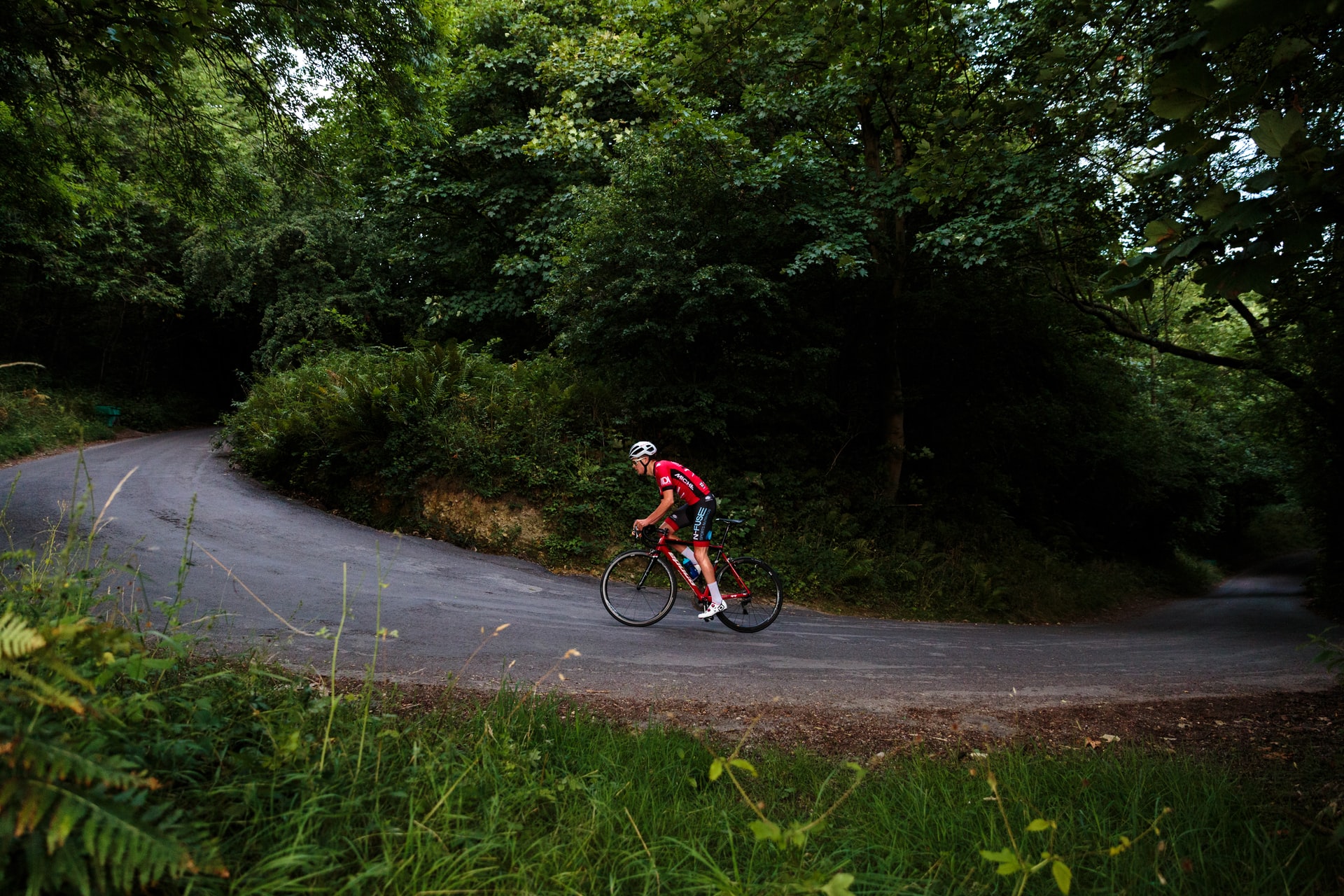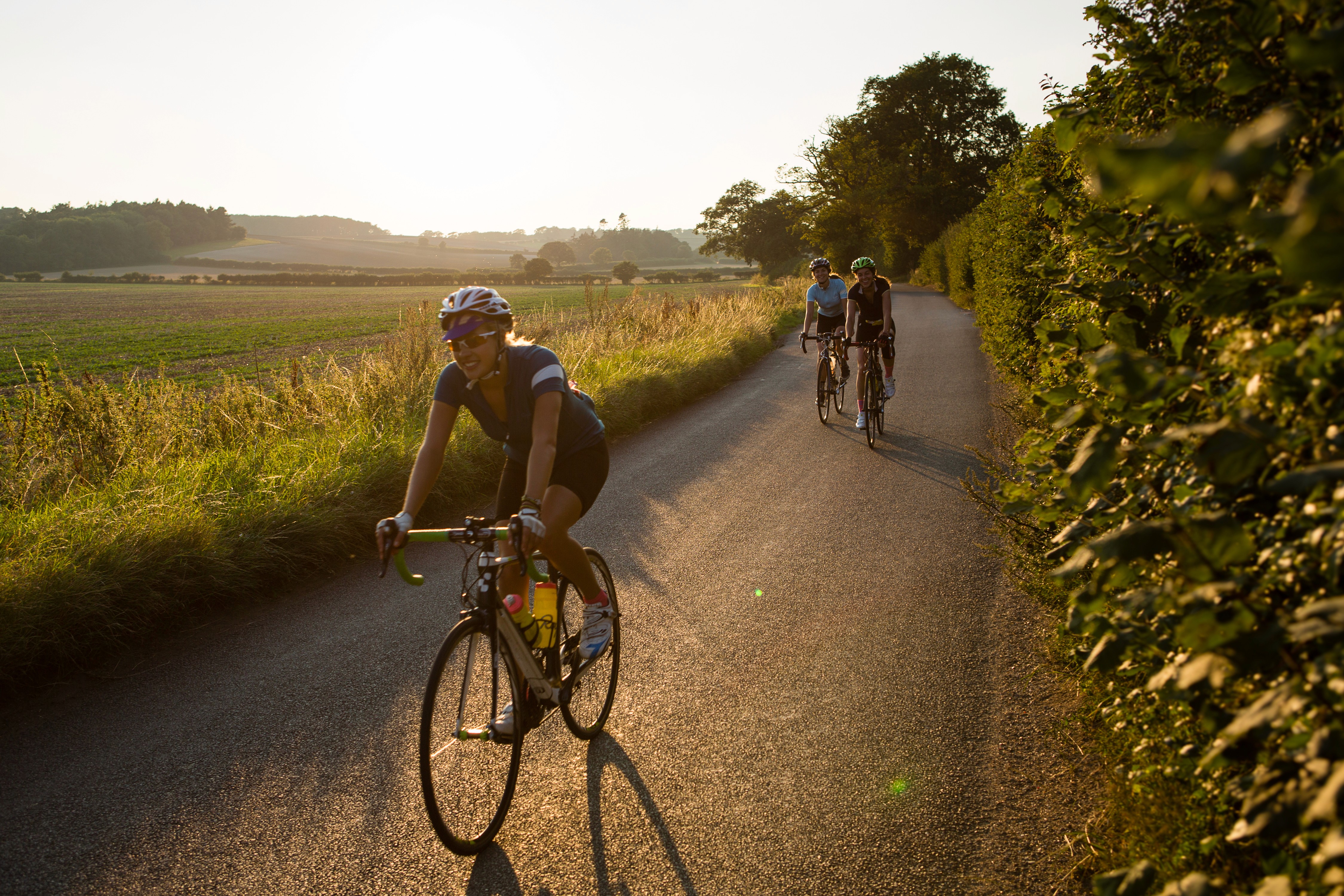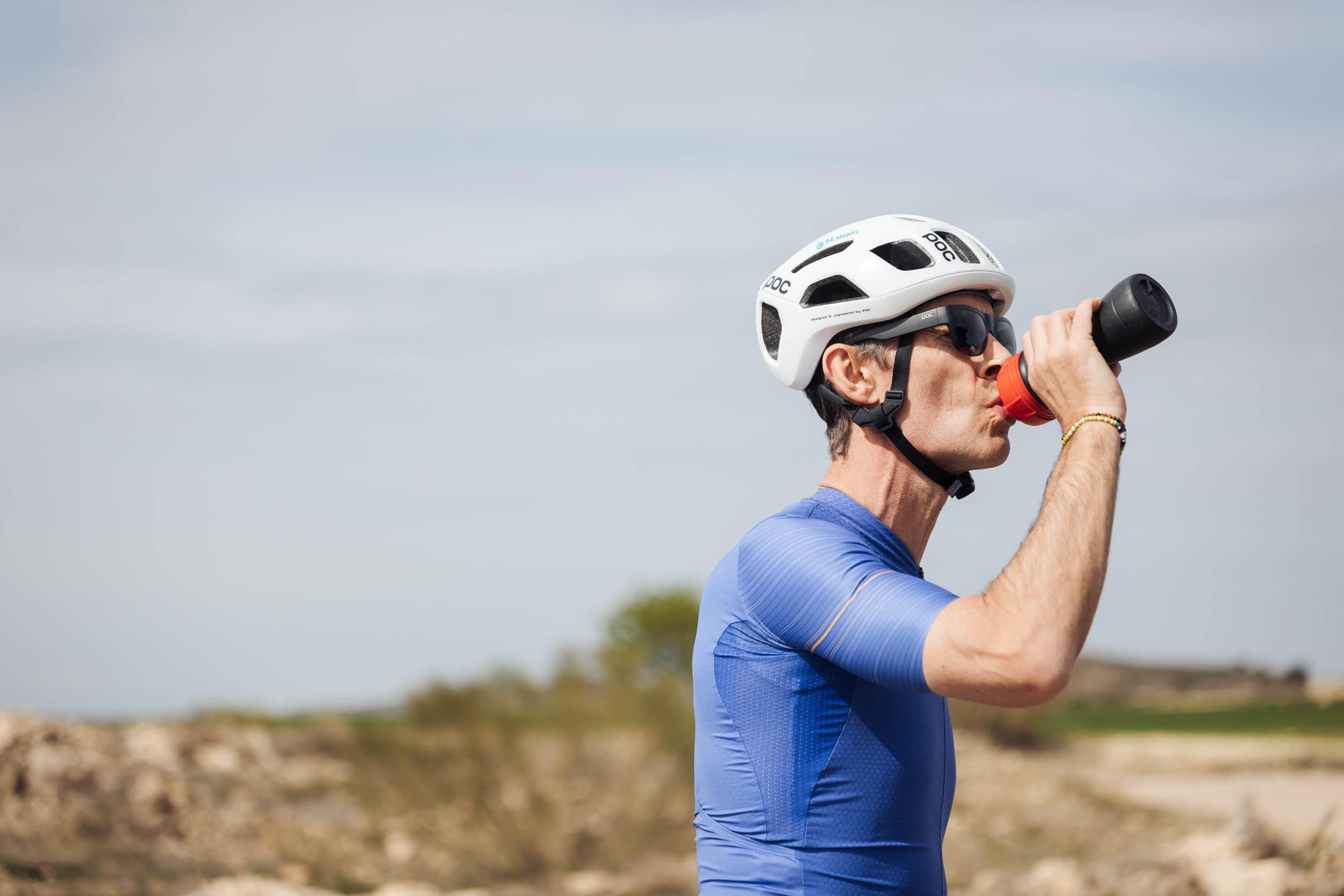Seated vs standing climbing

Sep 1, 2022

Seated vs standing climbing
Sep 1, 2022

Seated vs standing climbing

Sep 1, 2022

Sprinting, accelerating, descending or time trialing are all very nice to do, but nothing beats cycling up a beautiful mountain pass. There is nothing more rewarding than toiling your way up all those altitude meters arriving on a mountain top or a famous col. Everyone who has ever ridden up a serious climb has also wondered: should I stand on the pedals or stay in the saddle? Usually this question is answered unconsciously as you get out of the saddle on a hunch to try and give some suffering muscle groups a little relief. But which is actually better and where and when should you get out of the saddle? In this article we address these questions.
More power and more muscle groups
The big difference between standing and seated climbing is in the bio-mechanics. When you stand on the pedals, literally all of your weight is in a straight line above the pedals. This allows you to use more muscles. In particular, your butt and calf muscles can now be recruited much more efficiently, while your quadriceps can also provide more power. In addition, your upper body, trunk and arm muscles can contribute to the forward cycling motion, which allows you to deliver more power overall.
Higher air resistance when climbing standing
By standing on the pedals, the frontal surface increases considerably and thus the air resistance. Part of the extra power generated by standing is therefore immediately lost to the increased air resistance. However, climbing is usually done at low speeds, so getting out of the saddle does not create a lot of extra resistance.
Type-II muscle fibers
So by climbing while standing you can deliver more power, just like with sprinting while standing. However, this always comes at a cost in terms of higher overall energy consumption, so you will build up more muscle fatigue. Research shows that this higher energy does not go hand in hand with a higher oxygen uptake. This means that this extra power is mostly generated by anaerobic, type-II muscle fibers. As a result, more oxygen is not immediately required to deliver the higher power output. However, this anaerobic energy has a limited availability, so at some point you have to go back in the saddle to recover and work off the lactic acid build up during that anaerobic effort.
Everybody who has ever done a long, mountainous cyclosportive ride will recognize this, as on the final climb you can only sustain climbing out of the saddle for a short while, if at all still. A study of high-level cyclists has found that they mainly climb out of the saddle to keep their speed as constant and as high as possible throughout a climb. On steep sections, these cyclists climbed standing for a short time and then on flatter sections they would go back in the saddle to recover.
The factors that determine when to stand
When is it better to stand than to stay seated? This is actually a fairly complex interplay of several factors. First of all, speed is important. If the speed is high, the extra power gained by standing is compensated by the increased air resistance. Of course, that speed is largely dependent on the steepness of the climb, but also on how strong you are. Research shows that climbing standing is especially beneficial when your power output is close to or above your threshold (or FTP). However, this point at which it is better to stand is different for each individual. It depends, for example, on the distribution of muscle fibers. Someone with a lot of anaerobic, type-II muscle fibers can stand longer and more often than someone with more aerobic, type-I muscle fibers.
Finally, body weight is also a very important factor. Because standing climbing involves putting all of one's weight above the pedals, a heavier cyclist must also support a greater weight. A lighter cyclist can therefore stand more often and for longer, while very heavy cyclists enjoy very few benefits at all from getting out of the saddle.
Practical tips
Finally, three important tips to keep in mind before you start on that magic climb. Firstly, shift gears a little heavier when you stand. Because you engage more muscle groups when climbing out of the saddle, the coordination also becomes more complex. If the pedaling frequency is too high, the cycling movement will quickly become inefficient because you will be working against your coordination. Therefore, ideally ride with a cadence about 5 to 10 rpm lower than sitting down. Secondly, don't sway the bike from left to right. This might look rather impressive, but it also increases rolling resistance. A slight swaying motion can help to improve the bio-mechanical transfer from your hip to your pedals, but don't overdo it.
The last and perhaps most important tip is to not underestimate the intelligence of the human body. Your body can tell you when to stand and when not to stand. Try not to override your brain when it tells you something, but learn to listen to it.
Sprinting, accelerating, descending or time trialing are all very nice to do, but nothing beats cycling up a beautiful mountain pass. There is nothing more rewarding than toiling your way up all those altitude meters arriving on a mountain top or a famous col. Everyone who has ever ridden up a serious climb has also wondered: should I stand on the pedals or stay in the saddle? Usually this question is answered unconsciously as you get out of the saddle on a hunch to try and give some suffering muscle groups a little relief. But which is actually better and where and when should you get out of the saddle? In this article we address these questions.
More power and more muscle groups
The big difference between standing and seated climbing is in the bio-mechanics. When you stand on the pedals, literally all of your weight is in a straight line above the pedals. This allows you to use more muscles. In particular, your butt and calf muscles can now be recruited much more efficiently, while your quadriceps can also provide more power. In addition, your upper body, trunk and arm muscles can contribute to the forward cycling motion, which allows you to deliver more power overall.
Higher air resistance when climbing standing
By standing on the pedals, the frontal surface increases considerably and thus the air resistance. Part of the extra power generated by standing is therefore immediately lost to the increased air resistance. However, climbing is usually done at low speeds, so getting out of the saddle does not create a lot of extra resistance.
Type-II muscle fibers
So by climbing while standing you can deliver more power, just like with sprinting while standing. However, this always comes at a cost in terms of higher overall energy consumption, so you will build up more muscle fatigue. Research shows that this higher energy does not go hand in hand with a higher oxygen uptake. This means that this extra power is mostly generated by anaerobic, type-II muscle fibers. As a result, more oxygen is not immediately required to deliver the higher power output. However, this anaerobic energy has a limited availability, so at some point you have to go back in the saddle to recover and work off the lactic acid build up during that anaerobic effort.
Everybody who has ever done a long, mountainous cyclosportive ride will recognize this, as on the final climb you can only sustain climbing out of the saddle for a short while, if at all still. A study of high-level cyclists has found that they mainly climb out of the saddle to keep their speed as constant and as high as possible throughout a climb. On steep sections, these cyclists climbed standing for a short time and then on flatter sections they would go back in the saddle to recover.
The factors that determine when to stand
When is it better to stand than to stay seated? This is actually a fairly complex interplay of several factors. First of all, speed is important. If the speed is high, the extra power gained by standing is compensated by the increased air resistance. Of course, that speed is largely dependent on the steepness of the climb, but also on how strong you are. Research shows that climbing standing is especially beneficial when your power output is close to or above your threshold (or FTP). However, this point at which it is better to stand is different for each individual. It depends, for example, on the distribution of muscle fibers. Someone with a lot of anaerobic, type-II muscle fibers can stand longer and more often than someone with more aerobic, type-I muscle fibers.
Finally, body weight is also a very important factor. Because standing climbing involves putting all of one's weight above the pedals, a heavier cyclist must also support a greater weight. A lighter cyclist can therefore stand more often and for longer, while very heavy cyclists enjoy very few benefits at all from getting out of the saddle.
Practical tips
Finally, three important tips to keep in mind before you start on that magic climb. Firstly, shift gears a little heavier when you stand. Because you engage more muscle groups when climbing out of the saddle, the coordination also becomes more complex. If the pedaling frequency is too high, the cycling movement will quickly become inefficient because you will be working against your coordination. Therefore, ideally ride with a cadence about 5 to 10 rpm lower than sitting down. Secondly, don't sway the bike from left to right. This might look rather impressive, but it also increases rolling resistance. A slight swaying motion can help to improve the bio-mechanical transfer from your hip to your pedals, but don't overdo it.
The last and perhaps most important tip is to not underestimate the intelligence of the human body. Your body can tell you when to stand and when not to stand. Try not to override your brain when it tells you something, but learn to listen to it.
Sprinting, accelerating, descending or time trialing are all very nice to do, but nothing beats cycling up a beautiful mountain pass. There is nothing more rewarding than toiling your way up all those altitude meters arriving on a mountain top or a famous col. Everyone who has ever ridden up a serious climb has also wondered: should I stand on the pedals or stay in the saddle? Usually this question is answered unconsciously as you get out of the saddle on a hunch to try and give some suffering muscle groups a little relief. But which is actually better and where and when should you get out of the saddle? In this article we address these questions.
More power and more muscle groups
The big difference between standing and seated climbing is in the bio-mechanics. When you stand on the pedals, literally all of your weight is in a straight line above the pedals. This allows you to use more muscles. In particular, your butt and calf muscles can now be recruited much more efficiently, while your quadriceps can also provide more power. In addition, your upper body, trunk and arm muscles can contribute to the forward cycling motion, which allows you to deliver more power overall.
Higher air resistance when climbing standing
By standing on the pedals, the frontal surface increases considerably and thus the air resistance. Part of the extra power generated by standing is therefore immediately lost to the increased air resistance. However, climbing is usually done at low speeds, so getting out of the saddle does not create a lot of extra resistance.
Type-II muscle fibers
So by climbing while standing you can deliver more power, just like with sprinting while standing. However, this always comes at a cost in terms of higher overall energy consumption, so you will build up more muscle fatigue. Research shows that this higher energy does not go hand in hand with a higher oxygen uptake. This means that this extra power is mostly generated by anaerobic, type-II muscle fibers. As a result, more oxygen is not immediately required to deliver the higher power output. However, this anaerobic energy has a limited availability, so at some point you have to go back in the saddle to recover and work off the lactic acid build up during that anaerobic effort.
Everybody who has ever done a long, mountainous cyclosportive ride will recognize this, as on the final climb you can only sustain climbing out of the saddle for a short while, if at all still. A study of high-level cyclists has found that they mainly climb out of the saddle to keep their speed as constant and as high as possible throughout a climb. On steep sections, these cyclists climbed standing for a short time and then on flatter sections they would go back in the saddle to recover.
The factors that determine when to stand
When is it better to stand than to stay seated? This is actually a fairly complex interplay of several factors. First of all, speed is important. If the speed is high, the extra power gained by standing is compensated by the increased air resistance. Of course, that speed is largely dependent on the steepness of the climb, but also on how strong you are. Research shows that climbing standing is especially beneficial when your power output is close to or above your threshold (or FTP). However, this point at which it is better to stand is different for each individual. It depends, for example, on the distribution of muscle fibers. Someone with a lot of anaerobic, type-II muscle fibers can stand longer and more often than someone with more aerobic, type-I muscle fibers.
Finally, body weight is also a very important factor. Because standing climbing involves putting all of one's weight above the pedals, a heavier cyclist must also support a greater weight. A lighter cyclist can therefore stand more often and for longer, while very heavy cyclists enjoy very few benefits at all from getting out of the saddle.
Practical tips
Finally, three important tips to keep in mind before you start on that magic climb. Firstly, shift gears a little heavier when you stand. Because you engage more muscle groups when climbing out of the saddle, the coordination also becomes more complex. If the pedaling frequency is too high, the cycling movement will quickly become inefficient because you will be working against your coordination. Therefore, ideally ride with a cadence about 5 to 10 rpm lower than sitting down. Secondly, don't sway the bike from left to right. This might look rather impressive, but it also increases rolling resistance. A slight swaying motion can help to improve the bio-mechanical transfer from your hip to your pedals, but don't overdo it.
The last and perhaps most important tip is to not underestimate the intelligence of the human body. Your body can tell you when to stand and when not to stand. Try not to override your brain when it tells you something, but learn to listen to it.
More Relevant Articles
Discover valuable training tips to enhance your cycling performance.
More Relevant Articles
Discover valuable training tips to enhance your cycling performance.
More Relevant Articles
Discover valuable training tips to enhance your cycling performance.

Unlock Your Cycling Potential Today
Join thousands of cyclists who have improved their performance with JOIN's training plans.
Probeer het nu
Meer Informatie

Unlock Your Cycling Potential Today
Join thousands of cyclists who have improved their performance with JOIN's training plans.
By joining, you agree to our Terms and Conditions and our Privacy Policy.

Unlock Your Cycling Potential Today
Join thousands of cyclists who have improved their performance with JOIN's training plans.
By joining, you agree to our Terms and Conditions and our Privacy Policy.
Join Now
Join Now



